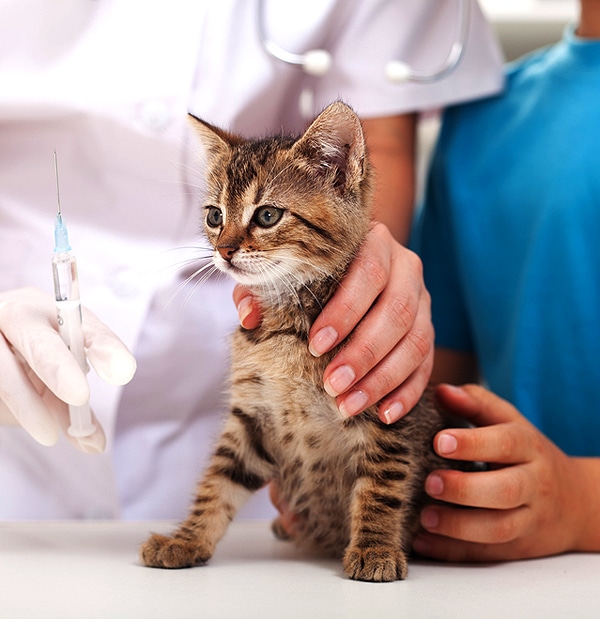The post Common Cat Vaccine Side Effects And How To Avoid Them by Dr. Eric Barchas appeared first on Catster. Copying over entire articles infringes on copyright laws. You may not be aware of it, but all of these articles were assigned, contracted and paid for, so they aren't considered public domain. However, we appreciate that you like the article and would love it if you continued sharing just the first paragraph of an article, then linking out to the rest of the piece on Catster.com.
For dogs and for humans, vaccines are one of the greatest advances — if not the very greatest advance — in the history of medicine. Nothing rivals vaccination when it comes to saving lives elegantly, effectively, and cheaply. There are relatively few drawbacks to vaccines in dogs and their owners.
Vaccines are more controversial in cats. The reason for the controversy boils down to one word: Sarcomas.
Sarcomas are aggressive cancers that have been linked to injections, including vaccinations, in cats. Originally it was thought that only the vaccines for rabies and feline leukemia virus caused sarcomas. It was hypothesized that a component of vaccines called adjuvant was responsible for the development of the nasty tumors. The cancers received the moniker vaccine associated sarcomas.

Since the discovery of the tumors, we have learned that injections other than vaccines also can trigger sarcomas. The name subsequently has been changed to injection site sarcomas, or IJS. The current theory is that inflammation, or bodily irritation, plays a substantial role in their development. Sarcomas appear to be a result of inflammation gone awry. Adjuvant triggers inflammation, so its presence does appear to increase the likelihood of sarcoma developing. However, the problem does not boil down to adjuvant alone.
Injection site sarcomas, as the name implies, develop in the tissues where an injection is administered. They may develop as soon as several weeks after the injection, or they may take years to form. Once they form they behave in an aggressive fashion. They spread locally into adjacent tissues, and they also may metastasize to distant parts of the body.
When I first started practicing veterinary medicine in 2000, I saw a significant number of sarcomas. The story usually went something like this: An owner would notice a lump in the area of her cat’s shoulder and would bring the cat in. I would palpate the lump, and usually could make a tentative diagnosis on the spot. If the mass was firm, irregular, located near the scruff, and connected to the deeper tissue it nearly always turned out to be a sarcoma.
I found so many sarcomas on shoulders because before the new millennium most cats received every vaccine in the scruff, which overlies the shoulders. The reason cats got shots in that spot was simple. The scruff is the easiest place to administer a vaccine.

Unfortunately, injection site sarcomas in the scruff usually turned out to be death sentences for cats in the early 2000s. The tumors grew back even when caught early and removed aggressively (with so-called wide margins). They usually grew back even when cats were referred to specialty centers for radical surgery and adjunctive treatment.
When I was in veterinary school in the 1990s I was taught to vaccinate cats in the rear legs, as close to the foot as possible. Rabies went into the right rear limb, and leukemia into the left. (Rabies right, leukemia left was an easy pneumonic.) When a tumor formed the vet was able to get a sense for which vaccine had caused the tumor. The tumor also could be completely removed through limb amputation. Everyone agreed that amputating a limb was a pathetic treatment, but sadly it was the best thing available. At the time it was not believed that the third vaccine that was commonly administered to cats, the FVRCP, caused tumors. The FVRCP therefore still went into the scruff. (Many vets now administer the vaccine in the right forelimb.)
Reputable outfits such as leading veterinary schools and the American Animal Hospital Association had been recommending the rabies right and leukemia left protocol for years by the time I started practicing. Triennial rather than annual vaccination was recommended as well.
In the early part of the 2000s, the recommendations didn’t seem to be making much difference. I suspect that was because old habits die hard. I knew many old-school vets who simply ignored the guidelines. I have heard it said that progress in medicine occurs one retirement at a time. Over time the number of sarcomas I saw began to decrease, and now I feel they are not common at all.
Nonetheless, sarcomas permanently changed the way vets and cat owners view feline vaccination. They are no longer epidemic, but they must be considered before any vaccination.

I have always considered sarcomas before vaccinating cats. Sarcomas are scary things when they happen. But although sarcomas are legitimate concerns for cat owners, it is important not to lose perspective. Disease is an even more important concern.
Talk with any cat lover who owned cats in the 1960s and you will hear heartbreaking stories of cats dying from feline leukemia virus. Speak with any person who works in a shelter and you will hear horror stories of entire cat wards being wiped out by panleukopenia while caretakers were helpless to intervene. And don’t forget that before the advent of rabies vaccines, cats could pose a significant risk of transmitting the most deadly infectious disease in the world to their owners. In fact, today cats are more likely than dogs to spread rabies in areas where rabies vaccines are mandatory for dogs but not for cats. And don’t forget that rabies isn’t only about people: No cat is known ever to have survived the disease.
Americans live in a scenario in which it is easy to be misled into believing that vaccines for panleukopenia, rabies, and leukemia are more dangerous than the diseases they prevent. This is not true. Vaccination has reduced the rates of these diseases, even among non-vaccinated animals. (The reduction in disease rates in non-vaccinated animals is part of a phenomenon called community or herd immunity — if everyone else is vaccinated, there is nobody from whom a non-vaccinated individual can catch the disease.) Great amounts of sickness and death would occur if everyone stopped vaccinating their cats.
What should a concerned cat owner do about the complex issue of vaccines in cats? I’ve been giving the same advice on Catster for nearly a decade: Find a good, knowledgeable vet who will take the time to sit down and discuss your cat’s lifestyle, age, and background. Decide with him which vaccines should be given, and how often.
Also, remember some basic rules. Vaccines are extremely important for kittens and quite important for young (less than two years old) cats but are less important for older individuals. Leukemia vaccines are more important for outdoor cats than for indoor cats. The benefits of rabies vaccination depend upon lifestyle and circumstances in the home. Finally, cats with familial histories of sarcomas may be at increased risk of tumors, so decreased vaccination frequency should be considered for them.
Learn how to live a better life with your cat on Catster:
- Ever Considered Adopting an Older or Disabled Cat? You Will After Seeing These Comics
- 5 Ways Cats Are Easier to Live With and Care for Than Dogs
- Are Laser Pointers Actually Good Cat Toys?
Other stories by Dr. Eric Barchas:
- Why Dental Disease Is the Most Common Problem Cats Face
- Why Do Vets Take Cats “Into the Back?” What Happens There?
- A “Day” in the Life of an Emergency Vet Is Actually a Night Shift
Featured Image Credit: Africa Studio, Shutterstock
The post Common Cat Vaccine Side Effects And How To Avoid Them by Dr. Eric Barchas appeared first on Catster. Copying over entire articles infringes on copyright laws. You may not be aware of it, but all of these articles were assigned, contracted and paid for, so they aren't considered public domain. However, we appreciate that you like the article and would love it if you continued sharing just the first paragraph of an article, then linking out to the rest of the piece on Catster.com.